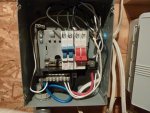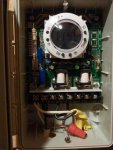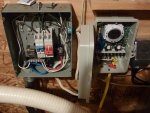- Sep 23, 2009
- 132
I bought a heavy duty GE mechanical timer and I followed instructions on how to wire it up tonight, but faced issues when I attempted to run the pump (issues = heard some "crackling" and saw some smoke coming from the timer's circuit board...  ). The timer says it's compatible with pretty much all voltages.
). The timer says it's compatible with pretty much all voltages.
So, here's the low down in my pool shed:
- piggy back fuse panel with 2 20 amp breakers which run the pump, and 2 15 amp breakers which run the pool's lighting and the shed's lighting.
The wiring that went directly from the 2 20 amp breakers in the piggy back box to my pump consisted of 1 black wire, 1 white wire, and a bare copper wire. I assumed this meant I was putting "110" to my pump, and so I followed instructions for wiring the timer to 110. I followed instructions to a tee (it only had about 4 steps, and included pictures...wasn't very tough), but once the pump had run for about 20 seconds, I got the crackling and the smoke ... at which point I quickly flipped the breaker. What gives?
 ). The timer says it's compatible with pretty much all voltages.
). The timer says it's compatible with pretty much all voltages. So, here's the low down in my pool shed:
- piggy back fuse panel with 2 20 amp breakers which run the pump, and 2 15 amp breakers which run the pool's lighting and the shed's lighting.
The wiring that went directly from the 2 20 amp breakers in the piggy back box to my pump consisted of 1 black wire, 1 white wire, and a bare copper wire. I assumed this meant I was putting "110" to my pump, and so I followed instructions for wiring the timer to 110. I followed instructions to a tee (it only had about 4 steps, and included pictures...wasn't very tough), but once the pump had run for about 20 seconds, I got the crackling and the smoke ... at which point I quickly flipped the breaker. What gives?





